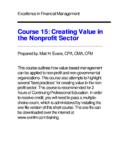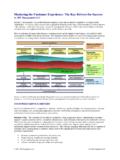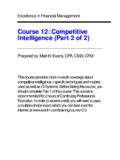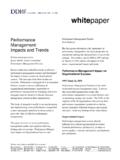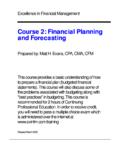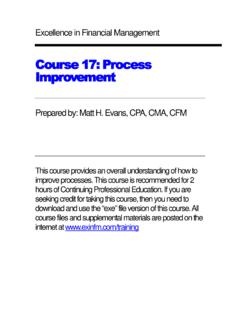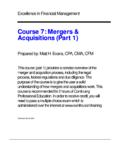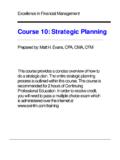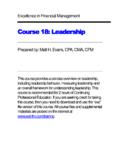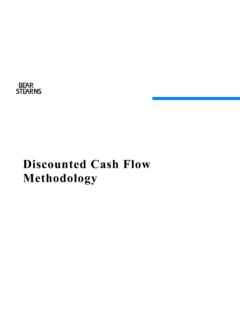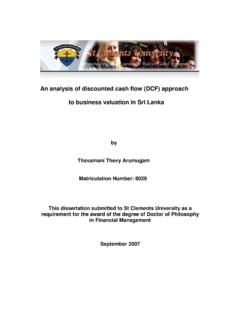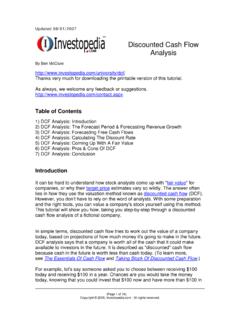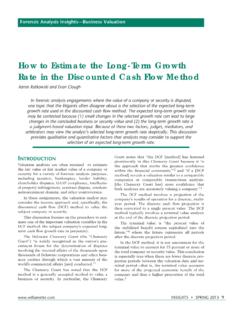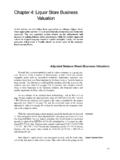Transcription of Course 3: Capital Budgeting Analysis - exinfm
1 Excellence in Financial Management Course 3: Capital Budgeting Analysis Prepared by: Matt H. Evans, CPA, CMA, CFM. This Course provides a concise overview of Capital Budgeting Analysis . This Course is recommended for 2 hours of Continuing Professional Education. In order to receive credit, you will need to pass a multiple choice exam which is administered over the internet at A companion toll free Course can be accessed by dialing 1-877-689-4097, option 3, ID 752. Chapter 1. The Overall Process Capital Expenditures Whenever we make an expenditure that generates a cash flow benefit for more than one year, this is a Capital expenditure.
2 Examples include the purchase of new equipment, expansion of production facilities, buying another company, acquiring new technologies, launching a research & development program, etc., etc., etc. Capital expenditures often involve large cash outlays with major implications on the future values of the company. Additionally, once we commit to making a Capital expenditure it is sometimes difficult to back- out. Therefore, we need to carefully analyze and evaluate proposed Capital expenditures. The Three Stages of Capital Budgeting Analysis Capital Budgeting Analysis is a process of evaluating how we invest in Capital assets; assets that provide cash flow benefits for more than one year.
3 We are trying to answer the following question: Will the future benefits of this project be large enough to justify the investment given the risk involved? It has been said that how we spend our money today determines what our value will be tomorrow. Therefore, we will focus much of our attention on present values so that we can understand how expenditures today influence values in the future. A very popular approach to looking at present values of projects is discounted cash flows or DCF. However, we will learn that this approach is too narrow for properly evaluating a project.
4 We will include three stages within Capital Budgeting Analysis : ! Decision Analysis for Knowledge Building ! Option Pricing to Establish Position ! discounted Cash Flow (DCF) for making the Investment Decision KEY POINT Do not force decisions to fit into discounted Cash Flows! You need to go through a three-stage process: Decision Analysis , Option Pricing, and discounted Cash Flow. This is one of the biggest mistakes made in financial management. Three Stages of Capital Budgeting Level of Uncertainty Decision 100%.
5 Analysis 80%. 60% Option 40% Pricing 20%. 0% DCF. $ $ $ Investment Amount Stage 1: Decision Analysis Decision-making is increasingly more complex today because of uncertainty. Additionally, most Capital projects will involve numerous variables and possible outcomes. For example, estimating cash flows associated with a project involves working Capital requirements, project risk, tax considerations, expected rates of inflation, and disposal values. We have to understand existing markets to forecast project revenues, assess competitive impacts of the project, and determine the life cycle of the project.
6 If our Capital project involves production, we have to understand operating costs, additional overheads, capacity utilization, and start- up costs. Consequently, we can not manage Capital projects by simply looking at the numbers; discounted cash flows. We must look at the entire decision and assess all relevant variables and outcomes within an analytical hierarchy. In financial management, we refer to this analytical hierarchy as the Multiple Attribute Decision Model (MADM). Multiple attributes are involved in Capital projects and each attribute in the decision needs to be weighed differently.
7 We will use an analytical hierarchy to structure the decision and derive the importance of attributes in relation to one another. We can think of MADM as a decision tree which breaks down a complex decision into component parts. This decision tree approach offers several advantages: ! We systematically consider both financial and non-financial criteria. ! Judgements and assumptions are included within the decision based on expected values. ! We focus more of our attention on those parts of the decision that are important.
8 ! We include the opinions and ideas of others into the decision. Group or team decision making is usually much better than one person analyzing the decision. Therefore, our first real step in Capital Budgeting is to obtain knowledge about the project and organize this knowledge into a decision tree. We can use software programs such as Expert Choice or Decision Pro to help us build a decision tree. 2. Simple Example of a Decision Tree: Stage 2: Option Pricing The uncertainty about our project is first reduced by obtaining knowledge and working the decision through a decision tree.
9 The second stage in this process is to consider all options or choices we have or should have for the project. Therefore, before we proceed to discounted cash flows we need to build a set of options into our project for managing unexpected changes. In financial management, consideration of options within Capital Budgeting is called contingent claims Analysis or option pricing. For example, suppose you have a choice between two boiler units for your factory. Boiler A uses oil and Boiler B can use either oil or natural gas.
10 Based on traditional approaches to Capital Budgeting , the least costs boiler was selected for purchase, namely Boiler A. However, if we consider option pricing Boiler B may be the best choice because we have a choice or option on what fuel we can use. Suppose we expect rising oil prices in the next five years. This will result in higher operating costs for Boiler A, but Boiler B can switch to a second fuel to better control operating costs. Consequently, we want to assess the options of Capital projects.
